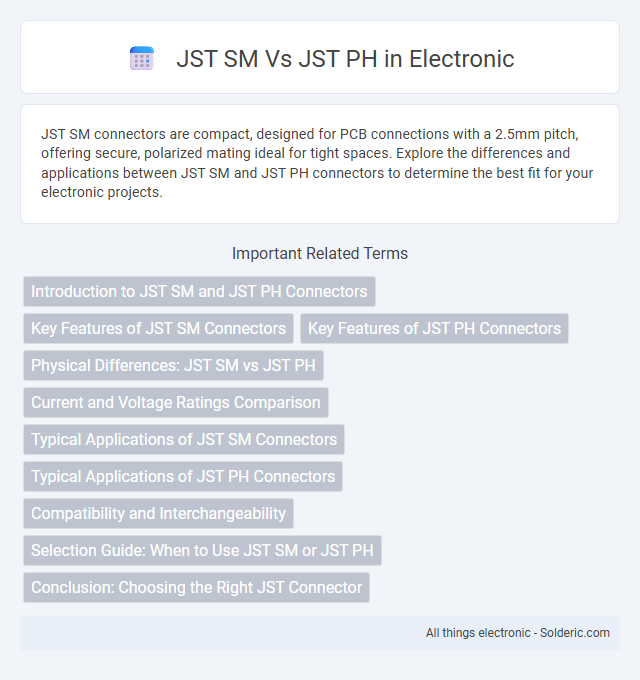JST SM connectors are compact, designed for PCB connections with a 2.5mm pitch, offering secure, polarized mating ideal for tight spaces. Explore the differences and applications between JST SM and JST PH connectors to determine the best fit for your electronic projects.
Comparison Table
| Feature | JST SM Series | JST PH Series |
|---|---|---|
| Pitch | 2.5 mm | 2.0 mm |
| Mount Type | Surface Mount (SMT) | Through-Hole |
| Current Rating | Up to 3A per circuit | Up to 2A per circuit |
| Contact Material | Phosphor bronze with gold plating | Phosphor bronze with tin plating |
| Typical Application | Compact PCB interconnections, SMT-compatible devices | Board-to-wire connections, prototyping, and general use |
| Connector Type | Housing with crimp terminals | Housing with crimp terminals |
| Number of Positions | 2 to 16 positions | 2 to 16 positions |
| Key Benefit | Low profile, SMT compatible for compact designs | Reliable through-hole connection, easy manual assembly |
Introduction to JST SM and JST PH Connectors
JST SM connectors are waterproof, connector type suitable for outdoor and LED lighting applications, characterized by a 2.5mm pitch and simple latch design for secure connections. JST PH connectors feature a compact 2.0mm pitch, primarily used in electronics for board-to-wire connections requiring precise and reliable contact. Both connector series serve distinct purposes, with JST SM favoring robust environmental resistance and JST PH emphasizing compactness and fine pitch for internal device wiring.
Key Features of JST SM Connectors
JST SM connectors feature a 2.5mm pitch and a robust locking mechanism that ensures secure connections ideal for LED strip lighting and small electronic devices. These connectors support single-row housing, compact size, and crimp-style terminals for easy wire attachment, enhancing reliability in signal and power transmission. Compared to JST PH connectors, which have a smaller 2.0mm pitch and are suited for thinner wires, JST SM connectors are preferred for applications requiring higher current capacity and mechanical stability.
Key Features of JST PH Connectors
JST PH connectors feature a 2.0mm pitch, compact design ideal for space-constrained applications and offer reliable locking mechanisms to ensure secure connections. These connectors support a current rating typically around 2A per contact and accommodate wire sizes from 28 to 22 AWG, making them suitable for signal and low-power electronics. Their polarized housings prevent incorrect mating, enhancing durability and ease of maintenance in devices such as consumer electronics and LED lighting systems.
Physical Differences: JST SM vs JST PH
JST SM connectors feature a pitch of 2.5mm, offering a slightly larger size ideal for robust connections requiring higher current capacity, while JST PH connectors have a smaller 2.0mm pitch, making them more suitable for compact, space-saving designs. The JST SM series typically includes pin headers and receptacles with a more rugged housing, providing enhanced mechanical stability compared to the thinner and more delicate casing of JST PH connectors. Understanding these physical differences ensures you select the right connector for your device's size constraints and electrical requirements.
Current and Voltage Ratings Comparison
JST SM connectors are rated for currents up to 3A per pin and voltages up to 250V AC, making them suitable for medium power applications. JST PH connectors typically support lower currents, around 2A per pin, and voltages up to 100V AC, which are ideal for low-power signal and data connections. The higher current and voltage ratings of JST SM connectors make them preferable for applications requiring robust power delivery compared to the more compact and lower-rated JST PH series.
Typical Applications of JST SM Connectors
JST SM connectors are widely used in LED lighting systems, automotive wiring harnesses, and small electronic devices due to their reliable locking mechanism and water-resistant features. Their design suits sensor connections, power supplies, and security alarm systems where durability and secure connections are crucial. Compared to JST PH connectors, SM connectors handle higher currents and provide a more robust connection for outdoor and industrial applications.
Typical Applications of JST PH Connectors
JST PH connectors are widely used in compact electronics such as drones, robotics, and small consumer devices due to their reliable 2.0mm pitch and secure locking mechanism. These connectors excel in applications requiring low-current signal and power transmission with a compact footprint. Your projects benefit from JST PH connectors' ease of use in tight spaces where JST SM connectors may be oversized or less suitable.
Compatibility and Interchangeability
JST SM connectors feature a 2.5mm pitch, making them suitable for applications requiring compact, secure connections, whereas JST PH connectors have a finer 2.0mm pitch commonly used in smaller electronic devices. These differences in pitch and pin size render JST SM and PH connectors incompatible and not directly interchangeable without risking connection failure or damage. Ensuring compatibility with your specific device is crucial when choosing between JST SM and PH connectors to maintain reliable performance.
Selection Guide: When to Use JST SM or JST PH
Choose JST SM connectors for compact, precision applications requiring secure locking and high durability, ideal in consumer electronics and small devices. Opt for JST PH connectors when ease of wiring, a 2.0mm pitch, and moderate current handling are needed, commonly found in LED strips and battery packs. The selection hinges on space constraints, locking mechanism preference, and electrical requirements.
Conclusion: Choosing the Right JST Connector
JST SM connectors offer a secure locking mechanism ideal for high-vibration environments, while JST PH connectors provide a compact design suited for space-constrained applications. Your choice depends on whether you prioritize durability and mechanical retention (JST SM) or size and ease of connection (JST PH). Evaluating the specific electrical and mechanical requirements ensures optimal performance and reliability in your project.
JST SM vs JST PH Infographic

 solderic.com
solderic.com